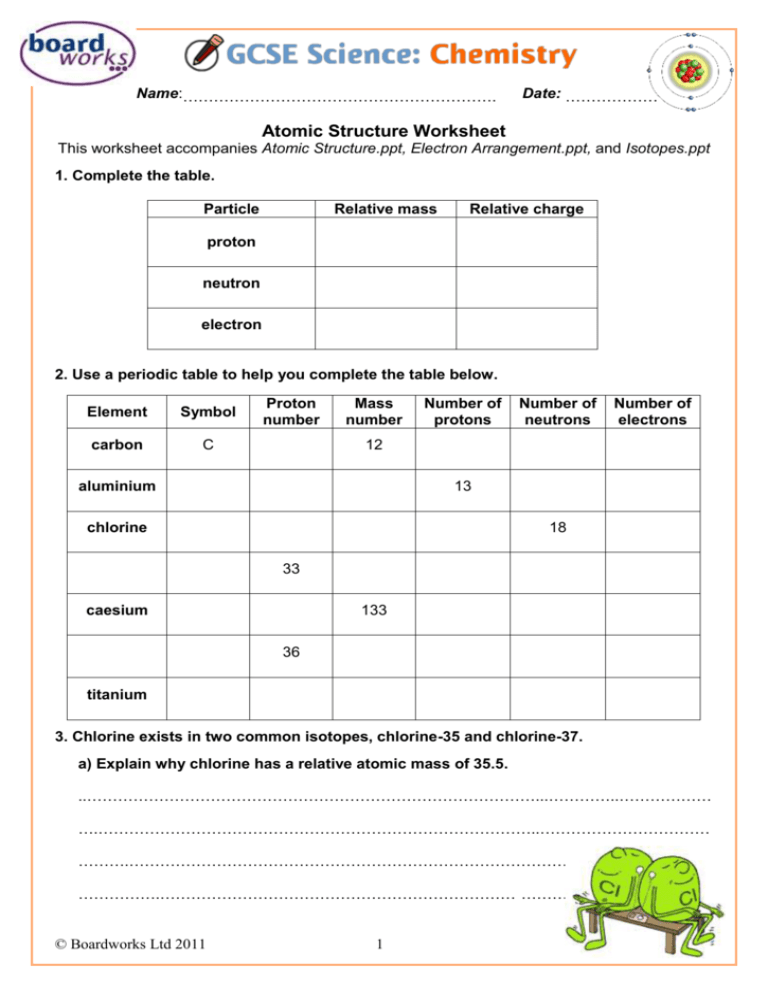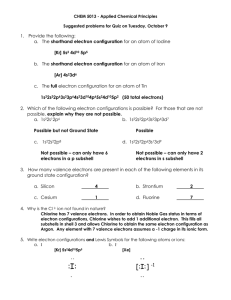Atomic Structure Worksheet
advertisement

Name:……………………………………………………. Date: ……………… Atomic Structure Worksheet This worksheet accompanies Atomic Structure.ppt, Electron Arrangement.ppt, and Isotopes.ppt 1. Complete the table. Particle Relative mass Relative charge proton neutron electron 2. Use a periodic table to help you complete the table below. Element Symbol carbon C Proton number Mass number Number of protons Number of neutrons Number of electrons 12 aluminium 13 chlorine 18 33 caesium 133 36 titanium 3. Chlorine exists in two common isotopes, chlorine-35 and chlorine-37. a) Explain why chlorine has a relative atomic mass of 35.5. ..……………………………………………………………………………...…………..……………… ….…………………………………………………………………………..…………………………… ……….………………………………………………………………………………………………… …………….…………………………………………………………… ……………………………… © Boardworks Ltd 2011 1 Name:……………………………………………………. Date: ……………… b) Compare the two isotopes of chlorine, stating what is similar and what is different between the two. ..………………………………………………………………………………………..…..………….… …………………………………………………………………………………………………………… ….…………………………………………………………………………………………..…………… ……………………………………………………………………………………………..……………. …………………………………………………………………………………………………………… ……………………………………………………………………………………..……………………. …………………………………………………………………………………………………………… ……………………………………………………………………..……………………………………. 4. Complete the electron structures of the following elements. © Boardworks Ltd 2011 hydrogen beryllium carbon neon 2 Name:……………………………………………………. Date: ……………… sodium silicon phosphorous argon potassium calcium © Boardworks Ltd 2011 3 Name:……………………………………………………. Date: ……………… 5. The electron arrangement of potassium can be written as 2.8.8.1. Work out the number of electrons in the following elements. Using the correct notation, write out the electron arrangement of each. a) lithium: Number of electrons …………… Electron structure …………… b) boron: Number of electrons …………… Electron structure …………… c) sulfur: Number of electrons …………… Electron structure …………… d) nitrogen: Number of electrons …………… Electron structure …………… e) magnesium: Number of electrons …………. Electron structure …………… f) silicon: Electron structure …………… Number of electrons …………… g) oxygen: Number of electrons …………… Electron structure …………… h) chlorine: Number of electrons …………… Electron structure …………… 6. Using examples from either group one or two of the periodic table, explain why elements in the same group have similar properties, with reference to electron arrangement. ..………………………………………………………………………………………...….. ……………………………………………………………………………………… …………….………………………………………………………………………... ………………………………….………………………………………………….. ……………………………………………………………………………………… ……………………………………………………………………………...………….…… ……………………………………………………………………………………………… ………………………………………………………………………...……………………. ……………………………………………………………………………………………… …………………………………………………………………… © Boardworks Ltd 2011 4








